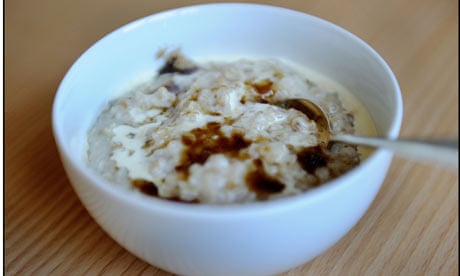If there's a season to get into porridge – king of hot, hearty, wholesome breakfasts – it is surely right now. You won't have to look far; we're currently in the midst of a porridge renaissance, with everyone from McDonald's to Michelin-starred restaurants serving it. Supermarket shelves are crammed full of oat products, but before you are tempted by exotic-sounding, fast-cooking porridges, take heed; making porridge is a serious matter, and in my opinion, the packet should contain nothing but oats.
Porridge is a subject that divides people. So, before I wade in brandishing my wooden spoon, having no spurtle (that's a porridge-stirring stick) to hand, I should admit that I am a born-again porridge eater. Having been brought up on Scott's Porage Oats by my Scottish mother, I lost my taste for it as a young chef, after subsisting entirely on said oats simmered in milk and sprinkled with granulated sugar. The memory of their bland, scalded milk flavour and gluey texture still makes me shiver.
My moment of oat enlightenment occurred at breakfast on the Isle of Harris five years ago. I was offered a bowl of porridge at Scarista House, a small hotel in the Outer Hebrides serving delicious food made from Scottish produce. The oats were accompanied by double cream and light muscovado sugar, combining to produce an exquisite sweet, oaty flavour. And the mixture was textured, yet light.
I quizzed cook Patricia Martin, who runs the hotel with her chef husband Tim. "We get Golspie Mill's organic medium oatmeal," she explained. "I soak it in cold water overnight, about double the volume of water to oatmeal. Then the next morning I add a little salt and slowly bring it up to the boil, whisking regularly. I add more water at that stage, then I let it bubble, giving it an occasional whisk, until it's ready. It should still have a little bite and be neither too stiff nor too soft."
Some months later, I was still craving Patricia's porridge, so I set about perfecting my own ultimate version.Porridge oats are sold in many forms: pinhead, rough and medium meal, rolled and jumbo oat flakes. Freshly harvested oats contain about 14% moisture, so have to be dried before and lightly toasted to develop their flavour. The more they're toasted, the deeper their taste. Their outer casing is removed by lightly grinding, leaving the groat (kernel). Cut in half this becomes pinhead meal – for example, John McCann's Steel Cut Irish Oat Meal (available from Waitrose). For me, these produce the most textured and flavoursome porridge.
Coarse and medium oatmeal are lightly ground, Golspie Mill and Oatmeal of Alford both sell them. The finer the oats, the smoother the texture of your porridge, but both will retain plenty of flavour. The more you stir or whisk them as you cook, the fluffier the resulting porridge – presumably because you are releasing more starch – just like making a risotto. Soaking can reduce cooking time slightly, but making porridge properly should be regarded as a slow, therapeutic task in itself.
Finally, quick-cooking rolled oats (invented by the Quaker Oat Company in the US in 1877), are whole or split groats that have been steamed and rolled to make oat flakes. The former are called "jumbo" oat flakes. They have a slightly lower nutritional value than unsteamed oats but rolled oats have the benefit of cooking within a few minutes. For me, organic rolled oats are gorgeous eaten raw in home-made muesli, but tasteless and pappy in porridge.
However, Martyn Nail, executive head chef at Claridge's, disagrees. He uses Peppercorn Eco Neutral Jumbo Oats, which he says produce a nutty flavoured, pleasantly textured porridge. But, far from cooking them quickly, Claridge's soak the oats in cold water for three hours, then gently cook with more water for 45 minutes.
"We prefer to let our guests salt their own porridge. They can add anything they like, but honey, maple syrup and chopped Medjool dates are all popular," says Nail cheerfully, as he munches his own morning bowlful – "it stops me eating the pastries". He then adds, "Porridge eaters tend to fall into two categories: porridge followed by the full English breakfast, or porridge followed by a fruit plate".
I eventually settled on my own perfect bowl of porridge: place a quarter of a cup (per person) of unsoaked McCann's steel cut oats in a pan with one cup (per person) of Scottish mineral water such as Speyside Glenlivet (which is soft and unchlorinated), to enhance their sweetness. Bring to the boil, add a pinch of sea salt to taste, stir thoroughly and simmer gently, stirring occasionally for a further 30 minutes. Add more water as necessary to ensure a creamy consistency. Then cover and leave to sit for a few minutes – this stops the porridge sticking to the bottom of the pan.
Serve with organic cream, light muscovado sugar and, if you are feeling decadent, accompany with a glass of Islay whisky, preferably a 16-year-old single malt Lagavulin. Heaven.
